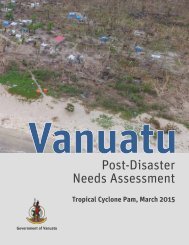Fiji
yqgk302EGjo
yqgk302EGjo
Create successful ePaper yourself
Turn your PDF publications into a flip-book with our unique Google optimized e-Paper software.
FIJI Post-Disaster Needs Assessment<br />
to medium term. Imports will be higher than previously expected with an inflow of machinery, equipment and materials for<br />
reconstruction for the replacement of infrastructure in the housing, telecommunication and transport sectors. Food imports<br />
are also expected to increase due to the loss of locally grown produce. These impacts will raise the trade in goods deficit by<br />
18.5 percent this year, which, as a percent of GDP, is now estimated to increase from 27.3 percent to 32.4 percent in 2016.<br />
The cyclone had minimal impact on the tourism sector, which is expected to fully recover during 2016. Aid in-kind and cash<br />
grants have risen following the cyclone and reconstruction financing is expected to result in higher inflows during 2016<br />
and beyond. Overall, <strong>Fiji</strong>’s Current Account deficit for 2016 is estimated to increase by 8.9 percent driven by lower export<br />
earnings and higher import payments. This will raise the Current Account deficit to 12.9 percent of GDP (at market price)<br />
in 2016.<br />
Table 6: Balance of Payments: Trade in Goods (F$ million)<br />
2015 Baseline 2016 Baseline % change<br />
2016 Postcyclone<br />
% Change: 2015<br />
to 2016 Post-<br />
Cyclone<br />
Exports 2,004 2,356 17.5 1,980 -1.2<br />
Imports 4,645 5,006 7.8 5,110 10.0<br />
Balance on Trade<br />
in Goods<br />
Source: Estimations by Macro Assessment Team.<br />
-2,641 -2,651 0.4 -3,130 18.5<br />
Fiscal Impact<br />
Government expenditure on disaster relief and early recovery activities are being funded through reprioritization of line<br />
ministry budgets. Notable reallocations included top ups for social welfare programmes and food ration distribution. In<br />
addition, around F$70 million will be set aside for the upcoming Help for Homes residential rehabilitation and assistance<br />
programme, and the diversion of funds into relief, recovery and reconstruction will reduce funds available for the government’s<br />
existing development programmes. Large additional expenditures are expected to be required once the reconstruction and<br />
recovery programmes are fully specified.<br />
In terms of the disaster impact on revenue collections, based on expected production flow losses for 2016 estimated in this<br />
PDNA, value added tax (VAT) collections are expected to decline by about F$61.9 million this year. In addition, there will be<br />
reductions in the Service Turnover Tax as a result of losses in the tourism sector.<br />
2.2 Employment, Livelihoods and Social<br />
Protection<br />
2.2.1 Summary<br />
TC Winston affected approximately 540,400 people or 62 percent of the national population of <strong>Fiji</strong> (estimated as 865,611 at<br />
the end of 2014). 19 TC Winston has resulted in the loss of 14,450,129 work days and F$351.45 million in personal income.<br />
Table 7 presents the distribution of the affected population by division. The largest proportion of the affected population<br />
was in the Western Division followed by the Central, Northern and Eastern Divisions. An estimated 263,000 women may<br />
have been affected by the disaster. 20<br />
The affected populations comprise those who lost their lives, were injured or fell ill due to the cyclone (together accounted<br />
for about 0.03 percent); the displaced (those whose homes were totally destroyed accounted for about 10 percent); and<br />
those whose livelihoods were affected (accounted for some 89.75 percent) as a result of TC Winston. In terms of livelihoods<br />
affected, 57 percent relate to the agricultural sector, 17 percent to commerce, 10 percent to manufacturing, and 8 percent<br />
to tourism and transportation equally.<br />
19<br />
Population and Labour Force Estimates 2014.<br />
20<br />
Population and Labour Force Estimates 2014 reported that women comprise 48.8 percent of the population.<br />
Tropical Cyclone Winston, February 20, 2016<br />
27



